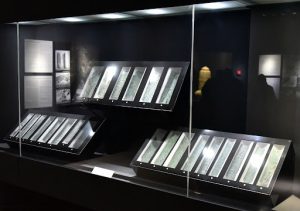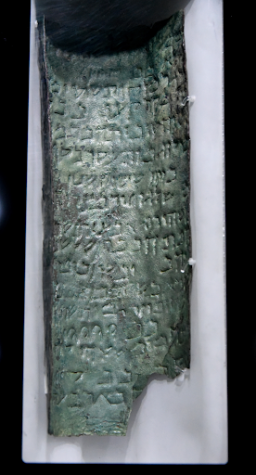Mysteries, Oddities, and Everything Strange: Copper Scroll
June 12, 2023
Copper Scroll: X Marks the Spot
National Treasure is a great movie. Everyone has seen Nicolas Cage absolutely demolishing federal agents while obtaining the Declaration of Independence to search for a treasure hundreds of years old. It only got a 46% on Rotten Tomatoes, but it has a perfect rating in my heart. Regardless, that type of mystery on a secret document is absolutely enamoring, and finding a hidden treasure on a measly piece of paper is alluring for any treasure seekers out there (like Nicolas Cage). What if I told you that there was a real version of this kind of secret?
 The copper scroll was one among the dead sea scrolls, documents and texts discovered throughout the Dead Sea between the years of 1946 and 1956 near the Qumran archeological site in Israel. They were mainly concentrated in this area, but passages were also uncovered in Jordan, Judea, and other locations in the area east of the Mediterranean Sea. The scrolls were written in a large combination of languages, including Latin, Greek, Arabic, and Hebrew. Most of the scrolls are in pieces, and they contain excerpts of everyday life, like marriage licenses and government documents. These scrolls were essential in constructing the Hebrew Bible and understanding life almost 2000 years ago. The fact that they were perfectly preserved was a miracle in archaeology.
The copper scroll was one among the dead sea scrolls, documents and texts discovered throughout the Dead Sea between the years of 1946 and 1956 near the Qumran archeological site in Israel. They were mainly concentrated in this area, but passages were also uncovered in Jordan, Judea, and other locations in the area east of the Mediterranean Sea. The scrolls were written in a large combination of languages, including Latin, Greek, Arabic, and Hebrew. Most of the scrolls are in pieces, and they contain excerpts of everyday life, like marriage licenses and government documents. These scrolls were essential in constructing the Hebrew Bible and understanding life almost 2000 years ago. The fact that they were perfectly preserved was a miracle in archaeology.
 The copper scroll is just one of the many legible fragments of the past discovered in Qumran. When all of the other scrolls from this collection were made of papyrus and paper, this item was made of, surprisingly, copper. Its contents also differed from the other artifacts collected in the same area, as it details the locations of various treasure sources in the area surrounding the Dead Sea (modern day Palestine). It was discovered by archaeologists instead of antiquities dealers, which allowed it to be studied much more thoroughly. The scroll was practically illegible when it was first discovered due to its oxidation and was too fragile to unravel, so the Manchester College of Science and Technology cut the scroll into multiple smaller pieces in 1956 in an attempt to decipher it.
The copper scroll is just one of the many legible fragments of the past discovered in Qumran. When all of the other scrolls from this collection were made of papyrus and paper, this item was made of, surprisingly, copper. Its contents also differed from the other artifacts collected in the same area, as it details the locations of various treasure sources in the area surrounding the Dead Sea (modern day Palestine). It was discovered by archaeologists instead of antiquities dealers, which allowed it to be studied much more thoroughly. The scroll was practically illegible when it was first discovered due to its oxidation and was too fragile to unravel, so the Manchester College of Science and Technology cut the scroll into multiple smaller pieces in 1956 in an attempt to decipher it.
The scroll also has some oddities hidden within its contents. There is a strange symbol present at the beginning of almost every section, which some hypothesize to be a code, but it has not been accurately solved yet. The text reads almost like an instruction manual, where the writer tells “you” to follow certain directions with specific measurements and directions. It describes locations surrounding Jerusalem and others throughout Israel. The treasures it suggests the existence of include gold, silver, coins, and other classic movie treasures. The value of the treasure described was estimated to be about $1,000,000 USD in 1960, equaling $10,250,000 USD today.
 People are searching for this treasure even today, over 70 years after its initial discovery. The treasure has not been found, though, because of the challenging language and vocabulary engraved in the metal sheet. Most of the dead sea scrolls were found to be religious texts, using words and language that would be found in the Bible. The copper scroll, however, took a major divergent path from this concept, and does not have any traces of religious themes whatsoever. Some words have been left undefined because the context of these ideas is completely unknown.
People are searching for this treasure even today, over 70 years after its initial discovery. The treasure has not been found, though, because of the challenging language and vocabulary engraved in the metal sheet. Most of the dead sea scrolls were found to be religious texts, using words and language that would be found in the Bible. The copper scroll, however, took a major divergent path from this concept, and does not have any traces of religious themes whatsoever. Some words have been left undefined because the context of these ideas is completely unknown.
Additionally, the geographical directions described in the passages are indecipherable in modern terms since archaeologists and anthropologists do not know where exactly they are located. The author describes specific gutters and underground passages that are likely completely buried or destroyed by 2000 years worth of erosion and human development.
The mystery of the copper scroll has put some at odds with its existence, since many do not believe that the scroll is real and the treasure is the work of fiction. Some believed it was the work of mysterious Jewish groups or royalty that kept it for safekeeping. Regardless of whether it is real or not, the mystery of locating treasure has been in the fantasies of pirates and young children wanting to be pirates alike. The copper scroll might never be solved, but it is a key in the history of humanity and the maintenance of treasure. It might be found someday, but for now, treasure hunting fantasies will remain in National Treasure.
Resources:
https://en.wikipedia.org/wiki/Copper_Scroll
https://dornsife.usc.edu/wsrp/copper-scroll/
https://www.asor.org/anetoday/2021/07/copper-scroll-qumran/
https://www.ancient-origins.net/news/lost-treasure-dead-sea-copper-scroll-001457





















































